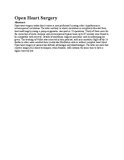| dc.description.abstract | Open heart surgery under direct vision is now performed by using either hypothermia or extracorporeal circulation. The latter method, in which circulation is completely diverted from heart and lungs by using a pump-oxygenator, was used in 53 operations. Thirty of these were for the correction of aortic stenosis, and extracorporeal bypass times up to 85 minutes were found to be compatible with survival. Details of anesthesia, surgical procedure, and recordkeeping are given. The tetralogy of Fallot was corrected in four patients, with zero mortality. Eight of the 14 deaths in other cases resulted from ventricular fibrillation with or without complete heart block. Open heart surgery at present has definite advantages and disadvantages. The latter are such that curative surgery by closed techniques, when feasible, will continue for some time to have a higher survival rate. | en |

